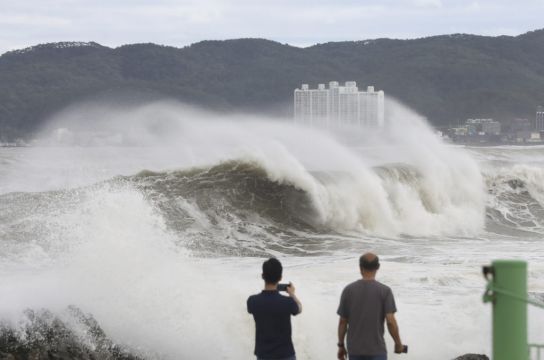The most powerful typhoon to hit South Korea in years battered its southern region on Tuesday, dumping 3ft (1m) of rain, destroying roads and felling power lines, leaving tens of thousands of homes without electricity, before weakening at sea.
Two people died, and some of the missing were trapped in a submerged basement car park.
Typhoon Hinnamnor grazed the resort island of Jeju and hit the mainland near the port city of Busan before blowing into the waters between the Korean Peninsula and Japan.

Hinnamnor’s winds weakened to 71mph (115kph) and the typhoon was expected to be downgraded to a tropical cyclone by night as it moves north-east between Russia and the northern Japanese island of Hokkaido, South Korea’s weather agency said.
The damage seemed most severe in the southern city of Pohang, where one person was found dead and at least nine others were missing after the storm submerged roads and buildings, triggered landslides and flooded a shopping centre.
Storm-damaged cars with their windows smashed or boots open were scattered on roads, while an entire two-storey pool villa was uprooted from the ground and swept away in flash floods.
Troops were deployed to assist with rescue and restoration efforts, moving in armoured vehicles rolling through streets that turned into chocolate-coloured rivers.

Hinnamnor made impact just weeks after heavy rains in the region around the capital, Seoul, caused flooding that killed at least 14 people.
The storm had dumped more than 41in (105cm) of rain in central Jeju since Sunday, where winds peaked at 96mph (155kph).
Southern and eastern mainland regions also suffered damage — signs and roofs were blown off, trees, traffic signs and electricity poles were toppled, and roads and car parks submerged.
A woman in her 70s died in Pohang after being swept away in flash floods, while another woman in her 80s died in nearby Gyeongju after her home was buried in a landslide.
The nine people missing in Pohang include eight stranded in a submerged car park.

In the nearby city of Ulsan, a 25-year-old man was unaccounted after falling into a rain-swollen stream, according to the Ministry of the Interior and Safety.
Also in Pohang, firefighters extinguished blazes that damaged at least three facilities at a major steel plant operated by Posco. A presidential official said officials were investigating the cause of the fires.
Local fire officials said the flames destroyed a building housing electricity equipment and damaged a separate office building and a cokes factory before being put out.
The Safety Ministry said about 500 of some 3,400 people who had been forced to evacuate had returned home as of Tuesday afternoon. Nearly 80 homes and buildings were flooded or destroyed, and hundreds of roads, bridges and facilities damaged.
More than 600 schools were closed or converted to online classes.
Workers had managed to restore electricity to 30,006 of the 66,341 households that lost power as of Tuesday afternoon.

In North Korea, state media reported “all-out efforts” to minimise damage from flooding and landslides.
The Korean Central News Agency reported that leader Kim Jong Un had issued unspecified “detailed tasks” to improve the country’s disaster response capacity, but it did not elaborate on the plans.
North Korea suffered serious damage from heavy rain and floods in 2020 which destroyed buildings, roads and crops, shocking the country’s already-crippled economy.







